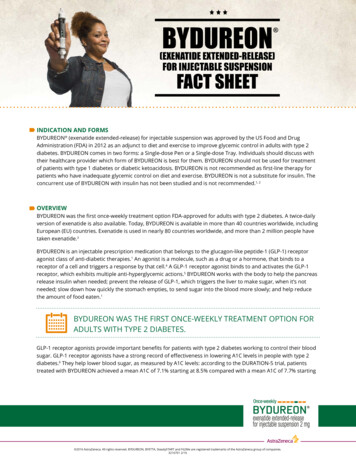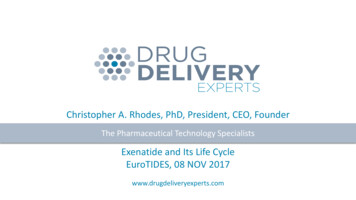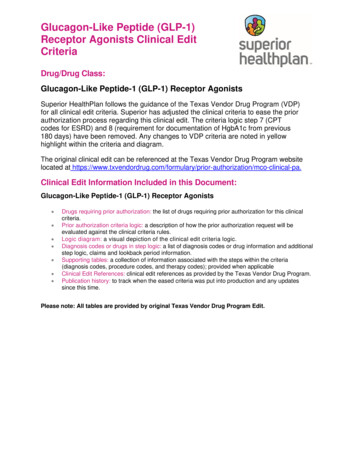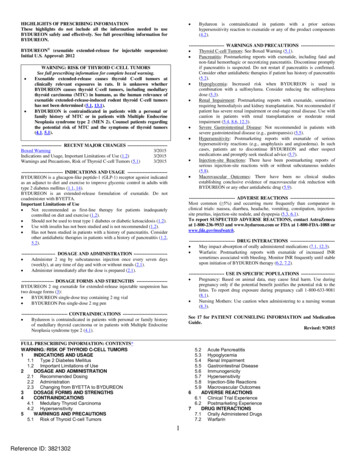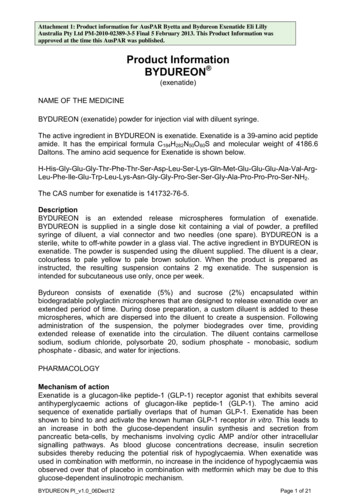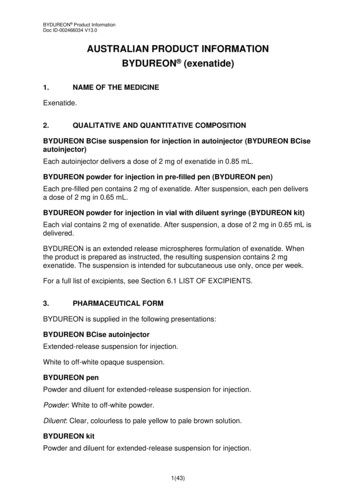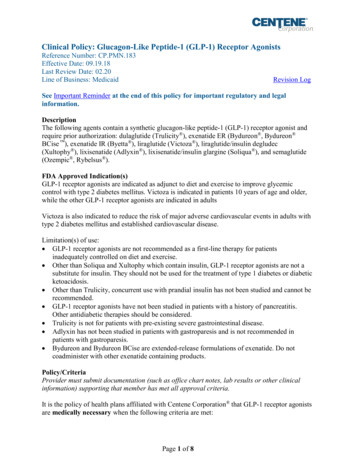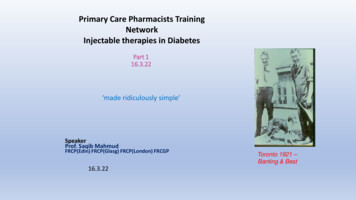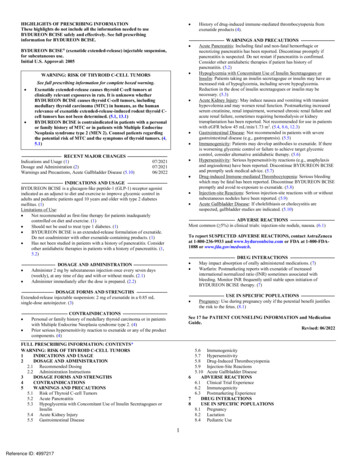
Transcription
HIGHLIGHTS OF PRESCRIBING INFORMATIONThese highlights do not include all the information needed to useBYDUREON BCISE safely and effectively. See full prescribinginformation for BYDUREON BCISE. ----------------------- WARNINGS AND PRECAUTIONS --------------------- Acute Pancreatitis: Including fatal and non-fatal hemorrhagic ornecrotizing pancreatitis has been reported. Discontinue promptly ifpancreatitis is suspected. Do not restart if pancreatitis is confirmed.Consider other antidiabetic therapies if patient has history ofpancreatitis. (5.2) Hypoglycemia with Concomitant Use of Insulin Secretagogues orInsulin: Patients taking an insulin secretagogue or insulin may have anincreased risk of hypoglycemia, including severe hypoglycemia.Reduction in the dose of insulin secretagogues or insulin may benecessary. (5.3) Acute Kidney Injury: May induce nausea and vomiting with transienthypovolemia and may worsen renal function. Postmarketing increasedserum creatinine, renal impairment, worsened chronic renal failure andacute renal failure, sometimes requiring hemodialysis or kidneytransplantation has been reported. Not recommended for use in patientswith eGFR below 45 mL/min/1.73 m2. (5.4, 8.6, 12.3) Gastrointestinal Disease: Not recommended in patients with severegastrointestinal disease (e.g., gastroparesis). (5.5) Immunogenicity: Patients may develop antibodies to exenatide. If thereis worsening glycemic control or failure to achieve target glycemiccontrol, consider alternative antidiabetic therapy. (5.6) Hypersensitivity: Serious hypersensitivity reactions (e.g., anaphylaxisand angioedema) have been reported. Discontinue BYDUREON BCISEand promptly seek medical advice. (5.7) Drug-induced Immune-mediated Thrombocytopenia: Serious bleedingwhich may be fatal has been reported. Discontinue BYDUREON BCISEpromptly and avoid re-exposure to exenatide. (5.8) Injection-site Reactions: Serious injection-site reactions with or withoutsubcutaneous nodules have been reported. (5.9) Acute Gallbladder Disease: If cholelithiasis or cholecystitis aresuspected, gallbladder studies are indicated. (5.10)BYDUREON BCISE (exenatide extended-release) injectable suspension,for subcutaneous use.Initial U.S. Approval: 2005WARNING: RISK OF THYROID C-CELL TUMORS See full prescribing information for complete boxed warning.Exenatide extended-release causes thyroid C-cell tumors atclinically relevant exposures in rats. It is unknown whetherBYDUREON BCISE causes thyroid C-cell tumors, includingmedullary thyroid carcinoma (MTC) in humans, as the humanrelevance of exenatide extended-release-induced rodent thyroid Ccell tumors has not been determined. (5.1, 13.1)BYDUREON BCISE is contraindicated in patients with a personalor family history of MTC or in patients with Multiple EndocrineNeoplasia syndrome type 2 (MEN 2). Counsel patients regardingthe potential risk of MTC and the symptoms of thyroid tumors. (4,5.1)-------------------------- RECENT MAJOR CHANGES -------------------------Indications and Usage (1)07/2021Dosage and Administration (2)07/2021Warnings and Precautions, Acute Gallbladder Disease (5.10)06/2022--------------------------- INDICATIONS AND USAGE -------------------------BYDUREON BCISE is a glucagon-like peptide-1 (GLP-1) receptor agonistindicated as an adjunct to diet and exercise to improve glycemic control inadults and pediatric patients aged 10 years and older with type 2 diabetesmellitus. (1)Limitations of Use: Not recommended as first-line therapy for patients inadequatelycontrolled on diet and exercise. (1) Should not be used to treat type 1 diabetes. (1) BYDUREON BCISE is an extended-release formulation of exenatide.Do not coadminister with other exenatide-containing products. (1) Has not been studied in patients with a history of pancreatitis. Considerother antidiabetic therapies in patients with a history of pancreatitis. (1,5.2)------------------------------ ADVERSE REACTIONS ----------------------------Most common ( 5%) in clinical trials: injection-site nodule, nausea. (6.1)To report SUSPECTED ADVERSE REACTIONS, contact AstraZenecaat 1-800-236-9933 and www.bydureonbcise.com or FDA at 1-800-FDA1088 or - DRUG INTERACTIONS ---------------------------- May impact absorption of orally administered medications. (7) Warfarin: Postmarketing reports with exenatide of increasedinternational normalized ratio (INR) sometimes associated withbleeding. Monitor INR frequently until stable upon initiation ofBYDUREON BCISE therapy. (7)---------------------- DOSAGE AND ADMINISTRATION --------------------- Administer 2 mg by subcutaneous injection once every seven days(weekly), at any time of day and with or without meals. (2.1) Administer immediately after the dose is prepared. (2.2)--------------------- DOSAGE FORMS AND STRENGTHS -------------------Extended-release injectable suspension: 2 mg of exenatide in a 0.85 mLsingle-dose autoinjector. (3)----------------------- USE IN SPECIFIC POPULATIONS --------------------- Pregnancy: Use during pregnancy only if the potential benefit justifiesthe risk to the fetus. (8.1)------------------------------ CONTRAINDICATIONS ---------------------------- Personal or family history of medullary thyroid carcinoma or in patientswith Multiple Endocrine Neoplasia syndrome type 2. (4) Prior serious hypersensitivity reaction to exenatide or any of the productcomponents. (4)See 17 for PATIENT COUNSELING INFORMATION and MedicationGuide.Revised: 06/2022FULL PRESCRIBING INFORMATION: CONTENTS*WARNING: RISK OF THYROID C-CELL TUMORS1INDICATIONS AND USAGE2DOSAGE AND ADMINISTRATION2.1 Recommended Dosing2.2 Administration Instructions3DOSAGE FORMS AND STRENGTHS4CONTRAINDICATIONS5WARNINGS AND PRECAUTIONS5.1 Risk of Thyroid C-cell Tumors5.2 Acute Pancreatitis5.3 Hypoglycemia with Concomitant Use of Insulin Secretagogues orInsulin5.4 Acute Kidney Injury5.5 Gastrointestinal Disease5.6 Immunogenicity5.7 Hypersensitivity5.8 Drug-Induced Thrombocytopenia5.9 Injection-Site Reactions5.10 Acute Gallbladder Disease6ADVERSE REACTIONS6.1 Clinical Trial Experience6.2 Immunogenicity6.3 Postmarketing Experience7DRUG INTERACTIONS8USE IN SPECIFIC POPULATIONS8.1 Pregnancy8.2 Lactation8.4 Pediatric Use1Reference ID: 4997217History of drug-induced immune-mediated thrombocytopenia fromexenatide products (4).
10111213148.58.6Geriatric UseRenal ImpairmentOVERDOSAGEDESCRIPTIONCLINICAL PHARMACOLOGY12.1 Mechanism of Action12.2 Pharmacodynamics12.3 PharmacokineticsNONCLINICAL TOXICOLOGY13.1 Carcinogenesis, Mutagenesis, Impairment of FertilityCLINICAL STUDIES14.1 Glycemic Control Trials in Adults with Type 2 Diabetes Mellitus14.2 EXSCEL Cardiovascular Outcomes Trial in Patients with Type 2Diabetes14.3 Glycemic Control Trial in Pediatric Patients 10 Years of Age andOlder with Type 2 Diabetes Mellitus16HOW SUPPLIED/STORAGE AND HANDLING17PATIENT COUNSELING INFORMATION*Sections or subsections omitted from the full prescribing information are notlisted.2Reference ID: 4997217
FULL PRESCRIBING INFORMATIONWARNING: RISK OF THYROID C-CELL TUMORS 1Exenatide extended-release causes an increased incidence in thyroid C-cell tumors atclinically relevant exposures in rats compared to controls. It is unknown whetherBYDUREON BCISE causes thyroid C-cell tumors, including medullary thyroid carcinoma(MTC), in humans, as the human relevance of exenatide extended-release-induced rodentthyroid C-cell tumors has not been determined [see Warnings and Precautions (5.1) andNonclinical Toxicology (13.1)].BYDUREON BCISE is contraindicated in patients with a personal or family history ofMTC and in patients with Multiple Endocrine Neoplasia syndrome type 2 (MEN 2).Counsel patients regarding the potential risk for MTC with the use of BYDUREONBCISE and inform them of symptoms of thyroid tumors (e.g., mass in the neck, dysphagia,dyspnea, persistent hoarseness). Routine monitoring of serum calcitonin or using thyroidultrasound is of uncertain value for detection of MTC in patients treated withBYDUREON BCISE [see Contraindications (4) and Warnings and Precautions (5.1)].INDICATIONS AND USAGEBYDUREON BCISE is indicated as an adjunct to diet and exercise to improve glycemic control in adultsand pediatric patients aged 10 years and older with type 2 diabetes mellitus [see Clinical Studies (14)].Limitations of Use BYDUREON BCISE is not recommended as first-line therapy for patients who have inadequateglycemic control on diet and exercise because of the uncertain relevance of the rat thyroid C-celltumor findings to humans [see Warnings and Precautions (5.1)]. BYDUREON BCISE is not indicated for use in patients with type 1 diabetes mellitus. BYDUREON BCISE is an extended-release formulation of exenatide and should not be used withother products containing the active ingredient exenatide. BYDUREON BCISE has not been studied in patients with a history of pancreatitis. Consider otherantidiabetic therapies in patients with a history of pancreatitis [see Warnings and Precautions (5.2)and Adverse Reactions (6.3)].2DOSAGE AND ADMINISTRATION2.1Recommended Dosing The recommended dose of BYDUREON BCISE is 2 mg subcutaneously once every 7 days(weekly). The dose can be administered at any time of day, with or without meals. Discontinue an immediate- or extended-release exenatide product prior to initiation of BYDUREONBCISE. Patients changing from another extended-release exenatide product to BYDUREON BCISEmay do so at the next regularly scheduled dose. Patients changing from immediate-release exenatide3Reference ID: 4997217
to BYDUREON BCISE may experience transient (approximately 2 to 4 weeks) elevations in bloodglucose concentrations. The day of weekly administration can be changed if necessary, as long as the last dose wasadministered 3 or more days before the new day of administration. If a dose is missed, administer the dose as soon as noticed, provided the next regularly scheduleddose is due at least 3 days later. Thereafter, patients can resume their usual dosing schedule of onceevery 7 days (weekly). If a dose is missed and the next regularly scheduled dose is due 1 or 2 days later, do not administerthe missed dose and instead resume BYDUREON BCISE with the next regularly scheduled dose.2.2Administration Instructions Prior to initiation, train patients and caregivers on proper mixing and injection [see Instructions forUse]. Instruct caregivers to assist pediatric patients with mixing and administration. Remove the autoinjector from the refrigerator 15 minutes prior to mixing the injection, in order toreach room temperature. Mix by shaking vigorously for at least 15 seconds. After mixing, BYDUREON BCISE shouldappear as an opaque, white to off-white suspension, evenly mixed with no residual medicine alongthe side, bottom or top of the inspection window. Inspect BYDUREON BCISE visually before use. The suspension should appear white to off-whiteand cloudy. Do not use if particulate matter is present or if discoloration is observed. Administer BYDUREON BCISE immediately after the autoinjector is prepared as a subcutaneousinjection in the abdomen, thigh, or upper arm region. Advise patients to use a different injection siteeach week when injecting in the same region.3DOSAGE FORMS AND STRENGTHSExtended-release injectable suspension: 2 mg of exenatide per 0.85 mL suspension, in a pre-filledsingle-dose autoinjector. Redispersion by mixing provides a white to off-white, opaque, suspension.4CONTRAINDICATIONSBYDUREON BCISE is contraindicated in patients with: A personal or family history of medullary thyroid carcinoma (MTC) or in patients with MultipleEndocrine Neoplasia syndrome type 2 (MEN 2). A prior serious hypersensitivity reaction to exenatide or to any of the excipients of BYDUREONBCISE. Serious hypersensitivity reactions including anaphylactic reactions and angioedema havebeen reported with exenatide [see Warnings and Precautions (5.7)].4Reference ID: 4997217
A history of drug-induced immune-mediated thrombocytopenia from exenatide products. Seriousbleeding, which may be fatal, from drug-induced immune-mediated thrombocytopenia has beenreported with exenatide use [see Warnings and Precautions (5.8)].5WARNINGS AND PRECAUTIONS5.1Risk of Thyroid C-cell TumorsIn both genders of rats, exenatide extended-release caused a dose-related and treatment-duration–dependent increase in the incidence of thyroid C-cell tumors (adenomas and/or carcinomas) at clinicallyrelevant exposures compared to controls [see Nonclinical Toxicology (13.1)]. A statistically significantincrease in malignant thyroid C-cell carcinomas was observed in female rats receiving exenatideextended-release at 27-times clinical exposure compared to controls and higher incidences were noted inmales above controls in all treated groups at 2-times clinical exposure. The potential of exenatideextended-release to induce C-cell tumors in mice has not been evaluated. Other GLP-1 receptor agonistshave also induced thyroid C-cell adenomas and carcinomas in male and female mice and rats at clinicallyrelevant exposures. It is unknown whether BYDUREON BCISE will cause thyroid C-cell tumors,including medullary thyroid carcinoma (MTC), in humans as the human relevance of exenatide extendedrelease–induced rodent thyroid C-cell tumors has not been determined.Cases of MTC in patients treated with liraglutide, another GLP-1 receptor agonist, have been reported inthe postmarketing period; the data in these reports are insufficient to establish or exclude a causalrelationship between MTC and GLP-1 receptor agonist use in humans.BYDUREON BCISE is contraindicated in patients with a personal or family history of MTC or inpatients with MEN 2. Counsel patients regarding the potential risk of MTC with the use of BYDUREONBCISE and inform them of symptoms of thyroid tumors (e.g., a mass in the neck, dysphagia, dyspnea,persistent hoarseness).Routine monitoring of serum calcitonin or using thyroid ultrasound is of uncertain value for earlydetection of MTC in patients treated with BYDUREON BCISE. Such monitoring may increase the risk ofunnecessary procedures, due to the low specificity of serum calcitonin testing for MTC and a highbackground incidence of thyroid disease. Significantly elevated serum calcitonin may indicate MTC andpatients with MTC usually have values 50 ng/L. If serum calcitonin is measured and found to beelevated, the patient should be further evaluated. Patients with thyroid nodules noted on physicalexamination or neck imaging should also be further evaluated.5.2Acute PancreatitisBased on postmarketing data, exenatide has been associated with acute pancreatitis, including fatal andnon-fatal hemorrhagic or necrotizing pancreatitis. After initiation of BYDUREON BCISE, observepatients carefully for signs and symptoms of pancreatitis (including persistent severe abdominal pain,sometimes radiating to the back, which may or may not be accompanied by vomiting). If pancreatitis issuspected, BYDUREON BCISE should promptly be discontinued and appropriate management should beinitiated. If pancreatitis is confirmed, BYDUREON BCISE should not be restarted. Consider antidiabetictherapies other than BYDUREON BCISE in patients with a history of pancreatitis. In clinical trials ofBYDUREON BCISE acute pancreatitis occurred in 0.4% of patients.5Reference ID: 4997217
5.3Hypoglycemia with Concomitant Use of Insulin Secretagogues or InsulinPatients receiving BYDUREON BCISE in combination with an insulin secretagogue (e.g., sulfonylurea)or insulin may have an increased risk of hypoglycemia, including severe hypoglycemia [see AdverseReactions (6.1) and Drug Interactions (7)].The risk of hypoglycemia may be lowered by a reduction in the dose of sulfonylurea (or otherconcomitantly administered insulin secretagogues) or insulin. Inform patients using these concomitantmedications of the risk of hypoglycemia and educate them on the signs and symptoms of hypoglycemia.5.4Acute Kidney InjuryBYDUREON BCISE may induce nausea and vomiting with transient hypovolemia and may worsen renalfunction. There have been postmarketing reports of altered renal function with exenatide, includingincreased serum creatinine, renal impairment, worsened chronic renal failure and acute renal failure,sometimes requiring hemodialysis or kidney transplantation. Some of these events occurred in patientsreceiving one or more pharmacologic agents known to affect renal function or hydration status such asangiotensin converting enzyme inhibitors, nonsteroidal anti-inflammatory drugs, or diuretics. Someevents occurred in patients who had been experiencing nausea, vomiting or diarrhea, with or withoutdehydration. Reversibility of altered renal function has been observed in many cases with supportivetreatment and discontinuation of potentially causative agents, including BYDUREON (exenatideextended-release for injectable suspension). BYDUREON BCISE is not recommended for use in patientswith an eGFR below 45 mL/min/1.73 m2 [see Use in Specific Populations (8.6)].5.5Gastrointestinal DiseaseExenatide has not been studied in patients with severe gastrointestinal disease, including gastroparesis.Because exenatide is commonly associated with gastrointestinal adverse reactions, including nausea,vomiting, and diarrhea, the use of BYDUREON BCISE is not recommended in patients with severegastrointestinal disease.5.6ImmunogenicityPatients may develop antibodies to exenatide following treatment with BYDUREON BCISE. Antiexenatide antibodies were measured in BYDUREON BCISE-treated patients in two comparatorcontrolled 28-week studies of BYDUREON BCISE. Patients with higher titer antibodies may have anattenuated HbA1c response. If there is worsening glycemic control or failure to achieve targeted glycemiccontrol, consider alternative antidiabetic therapy [see Adverse Reactions (6.2)].5.7HypersensitivityThere have been postmarketing reports of serious hypersensitivity reactions (e.g., anaphylaxis andangioedema) in patients treated with exenatide. If a hypersensitivity reaction occurs, the patient shoulddiscontinue BYDUREON BCISE and promptly seek medical advice [see Contraindications (4) andAdverse Reactions (6.3)]. Inform and closely monitor patients with a history of anaphylaxis orangioedema with another GLP-1 receptor agonist for allergic reactions, because it is unknown whethersuch patients will be predisposed to anaphylaxis with BYDUREON BCISE.6Reference ID: 4997217
5.8Drug-Induced ThrombocytopeniaSerious bleeding, which may be fatal, from drug-induced immune-mediated thrombocytopenia has beenreported in the postmarketing setting with exenatide use. Drug-induced thrombocytopenia is animmune-mediated reaction with exenatide-dependent anti-platelet antibodies. In the presence ofexenatide, these antibodies cause platelet destruction. If drug-induced thrombocytopenia is suspected,discontinue BYDUREON BCISE immediately and do not re-expose the patient to exenatide. Upondiscontinuation, thrombocytopenia can persist due to the prolonged exenatide exposure fromBYDUREON BCISE (about 10 weeks) [see Adverse Reactions (6.3)].5.9Injection-Site ReactionsThere have been postmarketing reports of serious injection-site reactions (e.g., abscess, cellulitis, andnecrosis), with or without subcutaneous nodules, with the use of BYDUREON [see Adverse Reactions(6.3)]. Isolated cases required surgical intervention.5.10Acute Gallbladder DiseaseAcute events of gallbladder disease, such as cholelithiasis or cholecystitis, have been reported in GLP-1receptor agonist trials and postmarketing. In the EXSCEL trial [see Clinical Studies (14.2)], 1.9% ofBYDUREON-treated patients and 1.4% of placebo-treated patients reported an acute event of gallbladderdisease, such as cholelithiasis or cholecystitis. If cholelithiasis is suspected, gallbladder studies andappropriate clinical follow-up are indicated.6ADVERSE REACTIONSThe following serious adverse reactions are described below or elsewhere in the prescribing information: Risk of Thyroid C-cell Tumors [see Warnings and Precautions (5.1)]Acute Pancreatitis [see Warnings and Precautions (5.2)]Hypoglycemia with Concomitant Use of Insulin Secretagogues or Insulin [see Warnings andPrecautions (5.3)]Acute Kidney Injury [see Warnings and Precautions (5.4)]Gastrointestinal Disease [see Warnings and Precautions (5.5)]Immunogenicity [see Warnings and Precautions (5.6)]Hypersensitivity [see Warnings and Precautions (5.7)]Drug-Induced Thrombocytopenia [see Warnings and Precautions (5.8)]Injection-Site Reactions [see Warnings and Precautions (5.9)]Acute Gallbladder Disease [see Warnings and Precautions (5.10)]6.1Clinical Trial ExperienceBecause clinical trials are conducted under widely varying conditions, adverse reaction rates observed inthe clinical trials of a drug cannot be directly compared to rates in the clinical trials of another drug andmay not reflect the rates observed in practice.The data in this section are derived from pooled data from the controlled period of the 2 comparatorcontrolled trials in adults as well as data from the extension phase of one of these trials [see Clinical7Reference ID: 4997217
Studies (14.1)]. There were 410 patients exposed to BYDUREON BCISE 2 mg for 28 weeks during thecontrolled phases, and an additional 116 patients exposed to BYDUREON BCISE 2 mg during anuncontrolled extension for an additional 24 weeks. Overall, there were 526 patients exposed toBYDUREON BCISE 2 mg with a mean duration of exposure of 35 weeks in the controlled and extensionphases of the two trials. Across the treatment arms in the controlled periods, the mean age of patients was55 years, 2% were 75 years or older and 59% were male. The population in these studies was 78% White,15% Black or African American, 5% Asian; 1% American Indian or Alaska Native; 1 % were NativeHawaiian or Pacific Islander; and 1% were other races. This population included 42% of Hispanic orLatino ethnicity. At baseline, the population had diabetes for an average of 8.3 years and had a meanHbA1c of 8.5%. Baseline estimated renal function was normal or mildly impaired (eGFR 60 mL/min/1.73 m2) in 93% of the pooled study populations.The safety of BYDUREON, another formulation of exenatide extended-release, in pediatric patients age10 to less than 18 years with type 2 diabetes was similar to that observed in the adults [see ClinicalStudies (14.3)].Common Adverse ReactionsTable 1 summarizes the adverse reactions with an incidence 5% occurring in BYDUREON BCISEtreated adult patients in the pooled data from the controlled and extension phases, including 10 weeks offollow-up, of the two comparator-controlled 28-week clinical trials. Adverse reactions were identifiedbased on known adverse reactions associated with BYDUREON.Table 1: Adverse Reactions Reported in 5% of BYDUREON BCISETreated Patients from Pooled Clinical Trial Data in Patients with Type 2Diabetes MellitusBYDUREON BCISE2 mgN 526%Injection site nodule10.5Nausea8.2Note: Percentages are based on the number of patients who were randomized and received at least one dose of BYDUREONBCISE.Nausea was a common adverse reaction associated with initiation of treatment with BYDUREON BCISEand usually decreased over time with continued use. The incidence of nausea and/or vomiting was 2% inthe first week of therapy compared to 1% in the 4th week of therapy.Less Common Adverse ReactionsAdverse reactions that occurred in 2% and 5% of adult patients receiving BYDUREON BCISE duringthe controlled and extension phases, including 10 weeks of follow-up, of the two comparator-controlled28-week clinical trials include: headache (4.4%), diarrhea (4.0%), vomiting (3.4%), injection site pruritus(3.2%), dizziness (2.5%), injection site erythema (2.3%), constipation (2.1%).8Reference ID: 4997217
Adverse Reactions Leading to Discontinuation of TherapyThe incidence of discontinuation of therapy due to adverse reactions was 3.9% for BYDUREONBCISE-treated patients in the two comparator-controlled 28-week trials in adults. The most commonclasses of adverse reactions leading to discontinuation of therapy for BYDUREON BCISE-treatedpatients were Gastrointestinal Disorders 2.0% and General Disorders and Administration Site Conditions1.2%. For BYDUREON BCISE-treated patients, the most frequent adverse reactions leading todiscontinuation of therapy within each of these respective classes were diarrhea (0.7%), nausea (0.7%),vomiting (0.5%) and injection-site nodule (0.5%).Other Adverse ReactionsHypoglycemiaTable 2 summarizes the incidence of glucose level 54 mg/dL regardless of hypoglycemia clinicalsymptoms and the incidence of severe hypoglycemia in the two comparator-controlled 28-week trials ofBYDUREON BCISE in adults.Table 2: Incidence (% of Subjects) of Hypoglycemia (glucose 54 mg/dL) andSevere Hypoglycemia in Clinical Trials in Patients with Type 2 Diabetes MellitusIncidence of Hypoglycemia (glucose 54 mg/dL)Mono- or Combination Therapy with One or Two OADs Trial (28 weeks)With Concomitant Sulfonylurea UseBYDUREON BCISE 2 mg (N 88)25.0%Without Concomitant Sulfonylurea UseBYDUREON BCISE 2 mg (N 141)2.1%Add-On to Metformin Trial (28 weeks)All treated subjectsBYDUREON BCISE 2 mg (N 181)0.0%Incidence of Severe HypoglycemiaMono- or Combination Therapy with One or Two OADs Trial (28 weeks)With Concomitant Sulfonylurea UseBYDUREON BCISE 2 mg (N 88)2.3%Without Concomitant Sulfonylurea UseBYDUREON BCISE 2 mg (N 141)0.7%Add-On to Metformin Trial (28 weeks)All treated subjectsBYDUREON BCISE 2 mg (N 181)0.0%Note: N and percentages are based on the number of patients who were randomized and received at least one dose ofBYDUREON BCISE.Severe hypoglycemia was defined as clinical symptoms that were considered to result from hypoglycemiain which the patient required the assistance of another person and associated with recovery after oralcarbohydrates, intravenous glucose or glucagon administration if no plasma glucose was available.In the 24-week pediatric placebo-controlled clinical trial [see Clinical Studies (14.3)], 2 (3.4%) ofBYDUREON-treated patients with type 2 diabetes had hypoglycemia with a blood glucose 54 mg/dL9Reference ID: 4997217
with or without symptoms and 1 (1.7%) had severe hypoglycemia (defined as an episode with severecognitive impairment requiring external assistance for recovery.Injection-Site Adverse ReactionsIn the two comparator-controlled 28-week trials in adults, injection site reactions (including injection sitenodule, injection site pruritus, injection site bruising) were observed in 23.9% of patients treated withBYDUREON BCISE. The formation of subcutaneous nodules is consistent with the properties of themicrospheres used in BYDUREON BCISE.Increase in Heart RateIn clinical trials of BYDUREON BCISE in adults, the mean increase from baseline in heart rate was 2.4beats per minute.Cholelithiasis and cholecystitisIn the EXSCEL trial [see Clinical Studies (14.2)], 1.9% of BYDUREON-treated patients and 1.4% ofplacebo-treated patients reported an acute event of gallbladder disease, such as cholelithiasis orcholecystitis.6.2ImmunogenicityAs with all therapeutic proteins, there is potential for immunogenicity. The detection of antibodyformation is highly dependent on the sensitivity and specificity of the assay. Additionally, the observedincidence of antibody (including neutralizing antibody) positivity in an assay may be influenced byseveral factors including assay methodology, sample handling, timing of sample collection, concomitantmedications, and underlying disease. For these reasons, comparison of the incidence of antibodies toexenatide in the studies described below with the incidence of antibodies in other studies or to otherproducts may be misleading.Anti-exenatide antibodies were measured at prespecified intervals in the two comparator-controlledstudies in adults, and evaluable anti-exenatide antibody measurements were available from 393BYDUREON BCISE-treated patients. In these trials 40.2% of these patients developed low titerantibodies to exenatide and approximately 33.8% of patients developed high titer antibodies at any timeduring the studies. The percentage of patients with positive antibody titers peaked at approximatelyWeeks 8-16 of dosing and then diminished over time.Change in HbA1c from baseline in patients with low titer antibodies at the last visit was generallycomparable to that observed in antibody-negative patients at the last visit. However, patients with highertiter antibodies may have an attenuated HbA1c response.Amongst BYDUREON BCISE-treated patients evaluable for antibodies (N 393), the incidence ofpotentially immunogenic injection site reactions (most commonly injection site nodule) during the28-week studies was approximately 19.6%. These reactions were less commonly observed inantibody-negative patients (15.7%) and patients with low titer antibodies (16.3%) compared with thosewith high titer antibodies (27.2%).10Reference ID: 4997217
Evaluation of anti-exenatide antibodies in select adult patients with high-titer antibodies havedemonstrated the potential for development of antibodies cross-reactive with endogenous GLP-1 andglucagon, but the clinical significance of these antibodies is not currently known. In the BYDUREONBCISE clinical trials, 133 patients developed high titer antibodies to exenatide and 118 of these patientshad samples and data for the cross-reactivity assay; one patient (0.8%) developed cross-reactiveantibodies to GLP-1 and/or glucagon. No information regarding the presence of neutralizing antibodies iscurrently available.In the pediatric study [see Clinical Studies (14.3)], the maximum antibody titer obtained at any timeduring the study was low ( 625) for approximately 30% of patients (17/57) and high ( 625) forapproximately 63% of patients (36/57). The percentage of patients with positive antibody titers peaked atapproximately Weeks 12 (58.8%, high tit
BYDUREON BCISE is not indicated for use in pati ents with type 1 diabetes mellitus. BYDUREON BCISE is an extended-release formulation of exenatide and should not be used with other products containing the active ingredient exenatide. BYDUREON BCISE has not been studied in patients with a history of pancreatitis. Consider other
